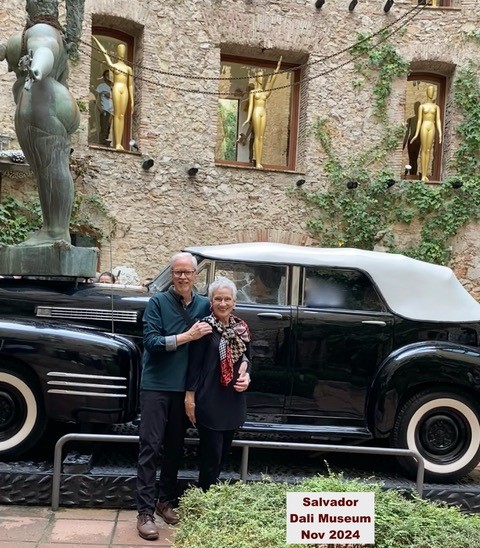

January 2025
I hesitated to disclose personal information in this newsletter as a private person. Then, I reflected on the knowledge and encouragement I gained from others, and I decided to share in hopes of helping others.
My high-grade serous ovarian cancer stage IIIC was diagnosed in 2020 and treated with debulking and carboplatin and paclitaxel (Taxol) chemotherapy. Four months later, a recurrence was treated with a second debulking. Two subsequent recurrences were treated with Taxol and Avastin chemotherapy, and then maintenance was treated with Avastin. Seven tumors were ablated with Stereotactic Body Radiation Therapy (SBRT). Now I am on Elahere and Avastin despite a low FRalpha receptor protein level.
For the past 50 years, my husband and I have maintained a healthy diet, sleep, and exercise habits, for which I am exceedingly grateful. We also thrive from our Lutheran faith, close family relations, and a few trusted friends. We strive to maintain a conservative, balanced approach to life.
In 1982, at age 34, breast cancer appeared; then, a new primary tumor in my other breast at age 40. Both were treated with mastectomy, no radiation or chemotherapy. Both of my sisters eventually developed breast cancer. We have an ATM mutation discovered on genetic testing in 2017, just 3 years before my ovarian cancer diagnosis. Unfortunately, the association between an ATM mutation and ovarian cancer was not yet as straightforward as it is now.
In February 2020, I told my primary care provider (PCP) that I did not feel well. An exam was inconclusive (sadly, a pelvic exam was not done). Despite never having fallen in decades of hiking, I had four serious falls in one year. Many other seemingly unrelated symptoms arose, including weakness, abdominal discomfort, gastric reflux, hearing loss, headaches, dizziness, and lack of mental focus. In July 2020, the onset of double vision led to an MRI displaying numerous scattered lacunar infarcts. An extensive workup for strokes was negative, and I finally asked about cancer and a CT scan. Would artificial intelligence have assisted in a prompter diagnosis?
Thus, ten months after symptoms began, my CT scan revealed a 13cm left ovarian mass. I was referred to a large local oncology group and underwent debulking surgery. Six infusions of carboplatin and paclitaxel chemotherapy ended in April 2021. Four months later, in August 2021, my CT scan revealed a 7cm tumor in the right pelvis. This indicated a poor prognosis.
Be sure you have a provider who scrutinizes the radiology scans, not just the reports. Radiologist reports have been a problem for me numerous times, and I very carefully review them. The radiologist who read my August 2021 CT scan made such an egregious mistake that I reported him to the Oregon Medical Board. This radiologist reported the 7cm tumor in my right pelvis as a reduction of the 13cm tumor in my left pelvis that had been removed months earlier. Sadly, my oncology providers only looked at this final radiology report, and they happily reported to me the reduction in tumor size! Their handling of this led to losing confidence in my oncology providers and significant changes for us.
Per these providers, surgery was not an option. We decided to go out of network and had the 7cm tumor removed in a 2nd debulking. Remarkably, I then went 12 months without a recurrence.
Be assertive in finding providers that truly suit you, as your life literally depends on it. In November 2021, I transferred to a different large oncology group where I continue to be very pleased with my care. We have also greatly benefited from multiple second opinions, dietitians, ostomy nurses, and palliative care.
My tumors are characterized as Platinum resistant, BRCA negative (less susceptible to PARPi), FRalpha negative (Elahere), low PD-L1 marker protein (Keytruda), and CA125 is not an indicator of my disease. Thus, following my 12 months of no recurrence, I have twice had 4 months of Taxol and Avastin infusions and Avastin maintenance.
Eventually, my metastases grew in small numbers and slowly, and the diagnosis of oligometastatic was added. Because of this and considerable research, pressure, and persistence, we were accepted for Stereotactic Body Radiation Therapy (SBRT) to ablate the following seven tumors (two at a time) as they slowly appeared over 5 months. It was an exciting and wonderful experience to have this relatively new treatment. Best of all, it gave me a “holiday” from chemotherapy to regain my strength.
Whenever my CT scan is negative, my husband joyfully books another trip. Since August 2021, we have taken 18 trips, including four-month-long European stays. In November 2024, after enjoying 5 weeks in Girona, Spain, my PET-CT scan revealed multiple tumors, and I am again on chemotherapy.
As we thank God for our many blessings and actively promote our health, we also accept what life offers. Our regular discussions about how to spend our remaining days together allow us to go through this process with grace.
